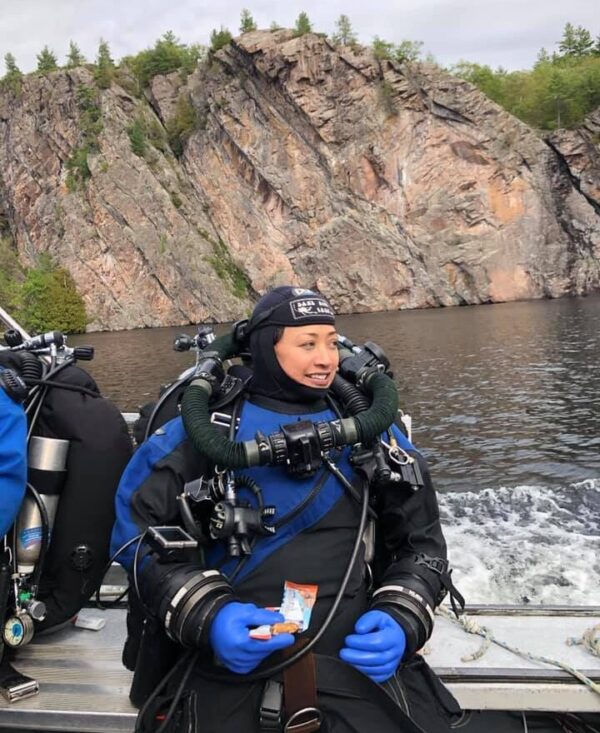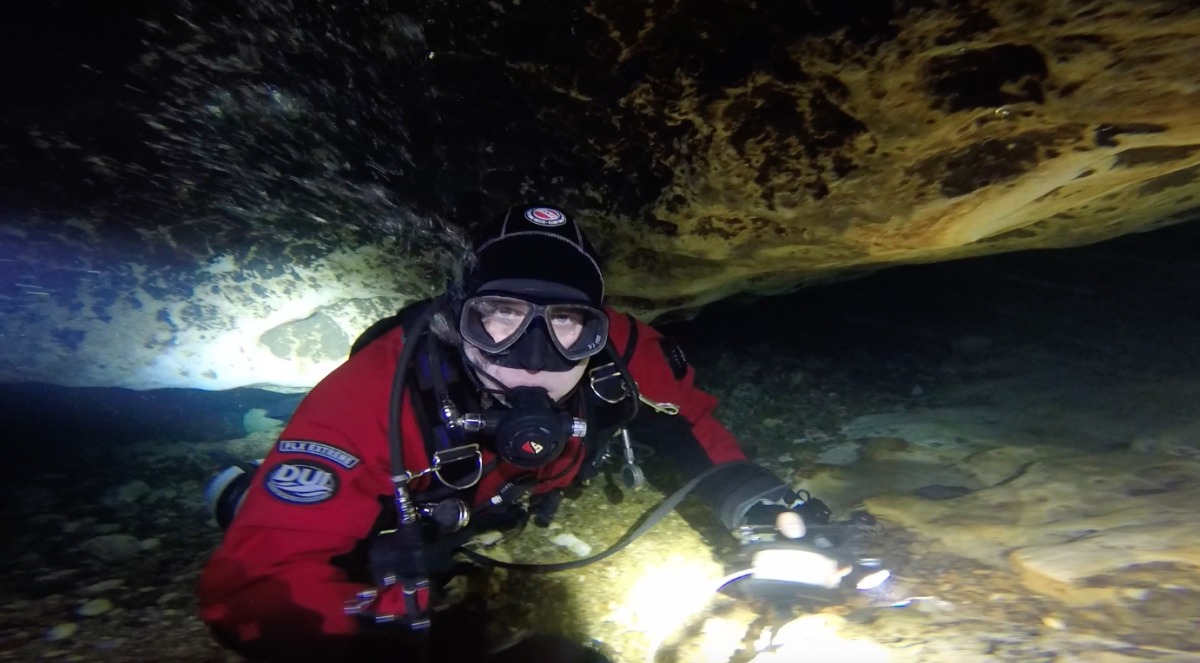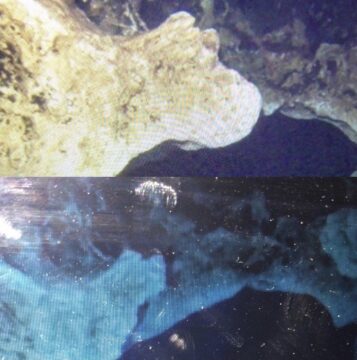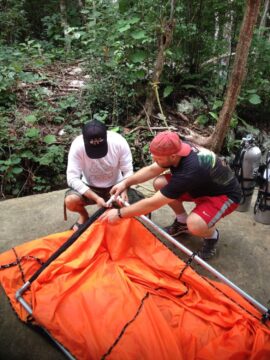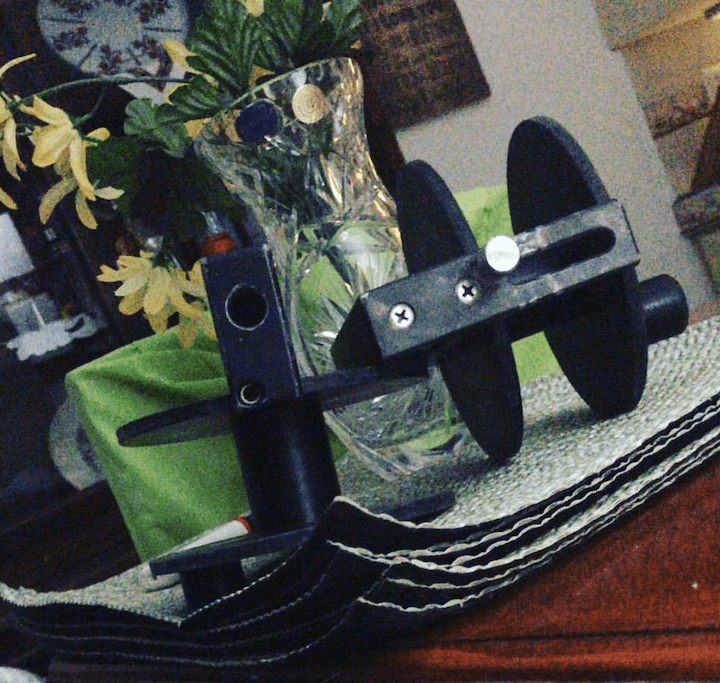When Should You Get a Rebreather
by
Matthew Mandziuk
Lately people have been asking us about rebreathers and when they should consider going that direction…So I figured “When Should You Get a Rebreather” would be a fun topic to write about.
Rebreathers are a simple concept. A rebreather is in essence like breathing from a “sealed bag” is filled with a breathable gas mixture. As you breath each breath, you deplete the oxygen in the “bag” through the process of metabolizing the oxygen and putting back in the lung exhaled breath with a lesser partial pressure of oxygen until the “sealed bag” or “lung” would go hypoxic (think of breathing in and out of a paper bag as a concept), meaning not enough oxygen is in the gas you’re breathing to sustain life.
You would have to replace the depleted oxygen with more oxygen, but in addition to this, you’ll also have make sure that carbon dioxide is also being absorbed/eliminated from your rebreathed gas, so we need to “scrub” the CO2 out with a CO2 “scrubber”….Sound simple? It is overall.
Below we will discuss who should dive a rebreather, the different basic designs and features, key elements, dive planning and more.
There are 2 main rebreather concepts. Semi-Closed and Fully Closed rebreathers.
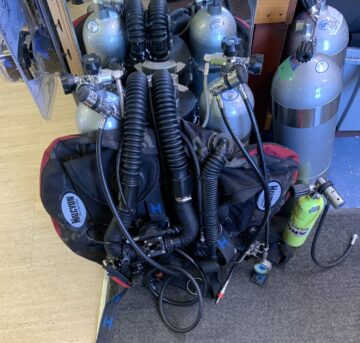
Semi-Closed is less popular for the vast majority because it’s a glorified gas extender with an efficiency ranging from 4:1, 8:1, and as high as 10:1 efficiency depending on the gas supply. They can use the same lung that a life-support patient breaths from which passively allows excess gas to vent from the bottom of the unit while the lung is refilled.
The Passive Semi-Closed Rebreather is very popular for depths where open and closed circuit scuba are less reliable. PSCR Divers often use larger cylinders.
Fully Closed Rebreathers utilize smaller tanks, a greater degree of efficiency as high as 40:1 that of open circuit because when the efficiency is met, the diver recycles the entire exhaled breath and only has to inject the oxygen when the PO2 drops. They can be more complicated but are more popular at the time of this writing
Rebreathers ARE NOT For Everyone
With the Cost of Helium increasing, more and more people are looking to breath more efficiently, however, diving a rebreather requires a higher level of awareness, technique, buoyancy, trim, knowledge of the machine and what can go wrong and how to troubleshoot problems.
It’s only a matter of time until Rebreathers become more common practice to the masses, however, now is not the time for most people because they don’t have the training or the experience.
Helium keeps going up and up, but that doesn’t mean unqualified Divers should be jumping in blind and bypassing all the experience and fun that is had learning and logging the experience dives that makes a person a better Diver.
Here are illustrations of a basic rebreather design and semi-closed rebreather design courtesy of the NAUI Rebreather Instructor Guide.
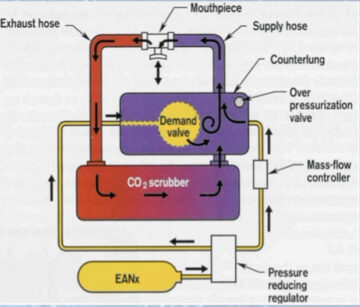
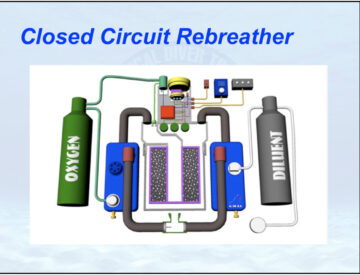
Types of Closed Circuit Rebreathers
Choosing the right rebreather for the individual is key. There is no perfect one rebreather of everybody.

Automatic: Some Divers prefer an automatic rebreather than much like a dive computer, runs the dive for them setting a constant PO2 (oxygen set point) for them on descent and maximum depth injecting oxygen using a solenoid .
Unless the Diver remembers to set the computer to a lower set point on ascent, this can cause problems for the Diver as the unit will continue to inject oxygen as the depth reduces because as the diver goes shallower, the Po2 will drop, so if the Diver ascends from depth at a PO2 set point of 1.2ata the rebreather will try to keep filling the lung with oxygen, whereas, the diver needs to set their set point lower to 0.6ata and they can ascend without worrying about an out of control ascent and manually adjust their set point to their desired level.
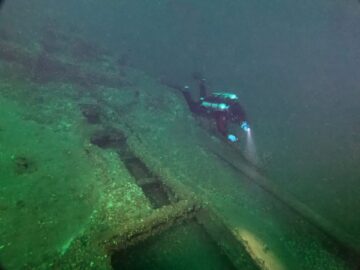
Continuous Mass Flow and Needle Valves: Some rebreathers use what’s called a needle valve which uses a “Mass Flow” orifice on the regulator of the O2 tank. The Diver can set their oxygen set point based on their metabolic oxygen rate by adjusting the Needle Valve.
The needle valve will gently flow oxygen into the counterlung so if the diver becomes task loaded and isn’t watching their Po2 (which should never happen), they needle valve will prevent the Diver from going Hypoxic.
You’ll find the Mass Flow a great option which is why the original KISS Rebreathers are still one of the simplest designs, while the updated Needle Valve design of Fathom CCR is becoming so popular.
The Continuous Mass Flow system is limited by depth. The intermediate pressure of the regulator first stage can reach the same as ambient pressure meaning an intermediate pressure in the first stage of 10BAR/145psi will not put out any more gas past 81msw/260fsw.
The Fathom System corrects the by modifying a diaphragm sealed first stage with a stronger spring which allows for safe boosting of the intermediate pressure up to as high as 205psi/14BAR which is capable of diving to depths of 120msw/395fsw. The pressure can also be increased up to 290psi/20bar for up to 585fsw or 177msw!!!
Excerp from the Fathom Page: “Smaller fixed-orifices can also be used for deeper depths with higher intermediate pressures but the risk of a blockage is increased and the options are limited by orifice availability. A fixed-orifice requires that the first stage intermediate pressure be adjusted to achieve a flow rate that corresponds to the diver’s metabolic needs, typically around 0.6 to 0.8 L/min. Conversely, the needle valve allows the first-stage intermediate pressure to be set to any pressure since the needle valve handles the flow adjustments. More importantly, the needle valve minimizes the risk of a blockage from debris since it can be opened up to allow small particles to pass. The oxygen MAV, which contains the needle-valve, is ported directly into the exhaust side of the head so oxygen must travel through the scrubber and mix with loop gas before reaching the diver.
1 (145 psi/14.7 psi/ata – 2 ata) x 33 fsw/ata = 260 fsw (Note: always subtract 2 ata when calculating the maximum operational depth of a CMF system.)”

Manual CCR: Manual Rebreathers are simple, easy to use, but require more attention to the instrumentation and require the operator to constantly inject oxygen based on their needs depressing an oxygen injection button allowing the Diver to adjust the oxygen as slowly or quickly as needed, in a similar fashion to how a diver would inflate their bcd.
When Diving a Manual CCR, the Diver will have to remember to monitor their Po2 and maintain the desired set point.
One of the more fun skills is “Volume Drop” which the CCR Diver will do in their initial training course to see how long it can take their mix to go near hypoxic from their targeted set point.
Keeping a consistent set point that mirrors a backup computer if there isn’t a second computer handset or NERD on the unit is a desired option.
Being diligent with keeping the oxygen level consistent is a must.
Simplicity and Reliability Should Favour Bells and Whistles
The more high tech of a rebreather, the more complacent some Divers get. Whether you’re flying an automatic or manual system you should always be aware of your set point and Do Your Pre-Dive Checklist!
A Rebreather is a very Serious Piece of Equipment.
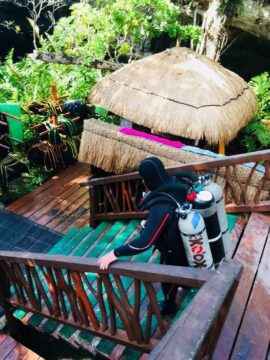
A rebreather is essentially a nitrox or trimix gas mixing system that is designed to deliver a constant oxygen set point that acts as a gas extender to you diving more efficient.
With each exhaled breath you make on open circuit scuba, there is no way to get that exhaled gas back.
A rebreather recycles your exhaled air, which is typically 5-6% less oxygen than you inhaled.
When you exhale into a rebreather, you’re exhaling into a scrubber canister, which is essentially a “filter cartridge” that is filled with a carbon dioxide absorbent, a granual that traps the CO2 on granules that resemble kitty litter called Soda lime, which is used to remove CO2 from breathing gases to prevent CO2 retention and CO2 Poisoning.
The filtered gas enters a counterlung that allows you re-breath this recycled gas and as it continues to be re-breathed, oxygen has to be added on occasion to prevent hypoxia (not enough oxygen)….Some have said that a rebreather is “essentially slowly trying to kill you, so maintaining the oxygen levels is essential.”
With each breath in we drop our oxygen PO2 so as the levels drop, we need to add oxygen to “bump” up the levels or the oxygen percentage you’re breathing can go hypoxic meaning you don’t have enough oxygen to sustain life and can go unconscious and die.
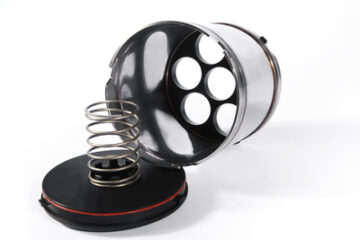

Think of the Scrubber and counterlung as your cardiovascular system.
Radial vs Axial Scrubber
Radial Scrubber allows the gas to pass through he canister body and provides a lower work of breathing, but is more difficult to pack than Axial Scrubber canister.
As the Co2 Absorbent becomes wet through moisture/condensation, the absorbent can clump, which can make it more difficult for the gas to pass through it, thus increasing the work of breathing.
Axial scrubber size/length needs to be long enough to prevent channelling of gas and short enough to keep the work of breathing low enough. A longer Axial scrubber will increase work of breathing.
For longer dives, a longer radial canister is much preferred as the work of breathing remains excellent on most designs.
There are also pre-packed scrubber cartridges available for some models of rebreather for the Diver who doesn’t want the responsibility or liability of packing a scrubber canister. These are more costly, but effective.
Rebreather Fatalities are (approximately) 10 Times More Common than Open Circuit Scuba Fatalities
Diving a Rebreather is very different than diving traditional Scuba. You can’t control buoyancy the same way and they don’t deliver gas the same way. Some even have a very complicated bunch of electronics or bulky, dangling bits everywhere and a huge, bulky counterlung.
Many CCR Divers can’t do a “try dive” on the unit they think they want to buy, so unfortunately, we see many people making Very Poor Choices in their Selection.
Your best rebreather is ultimately the one you think you want, but honestly, the simplest, most reliable and mores streamlined rebreather is the one for you.
Avoid Bells and Whistle’s, and run the unit in “manual” mode instead of an automatic rebreather. Be In Control of Your Oxygen Levels, don’t trust the machine to do it all for you.
Get as polished as you can be and as experienced as you can be before you jump into a rebreather.
Who Should Dive a Rebreather?
If the CCR Diver is wanting to dive the a pair of shipwrecks within recreational limits and dump their scrubber after the dives are completed, the cost of absorbent and gas fills will cost more than Nitrox fill in doubles would, so unless that Diver is planning a longer than “No Stop” recreational time limits, or saving the absorbent after the days diving wraps up for another day of diving, there is no benefit to using a rebreather on those dives, other than practice.
Cave Divers can spend hours underwater just on a single dive, as can shipwreck divers, technical divers and research divers. This is who a rebreather is best suited for.
NEVER ABANDON HOGARTHIAN/DIR/NTEC PRINCIPLES AND VALUES
Your rebreather configuration should be as streamlined as your doubles setup. Simple, Streamlined, Reliable, Familiar. Long hose is always off the right post, necklace (or BOV) is always off the left post so they don’t roll closed when swimming through a restriction like a cave or shipwreck.
Most CCR Divers Don’t Mirror Open Circuit (Long Hose, Backmounted Diluent, SPG Left Hip, etc.), which makes the system more complicated and in a situation where task loading can become a problem, that’s never good.

You should NEVER have to re-orient your stage bottle rigging (Always Valves Up Not Valves Down), positioning of your stages (Always Left Side). Running your valves “Valves Down” means your regulators are going to hit first when you do a stage drop. Those diving in the Great Lakes also have to worry about Zebra Muscles slicing into your hoses. It’s also easier to do a bubble check when your stage bottle valves are facing you.
Valves Up? or Valves Down on the Main Cylinders? Diving 3L Cylinders you will trim out better with the valves upright like a standard K Valve, but the Valves Down is acceptable for some configurations too.
When Diving CCR with Aluminum 40’s or Faber LP50’s Valves Up is the Most Modern and Most Reasonable Option.
Diving PSCR Valves Up is the Only Option as well, since the cylinders are larger and your’re mirroring your Open Circuit Doubles Configuration.
You can also get a Sidemount Rebreather in PSCR or CCR. Many of them do not breath well.
Remember the DIR…NTEC Principles are based around the concept of “Doing it Right”.
Another Type of rebreather….Chest Mount
Rebreathers like the Dive Rite O2ptima CM and Sub-Gravity FX CCR are chest mounted rebreathers that allow the diver to keep their original back or side mount configuration.
The units sit on the front of the body and have been used by the military and White Arrow Divers for decades as a decompression rebreather, but are improving in popularity for their attractive price tag, work of breathing and travel friendly size.
Not Enough Bailout Gas
One of the most common problems with rebreather divers is that they do not carry enough bailout gas!
You’ll sometimes see a cave or trimix diver doing a technical dive with 1-2 aluminum 40 cylinders. In the unlikely event the diver is equipped with 3L (FX23 cubic foot) tanks, they should have a minimum of 2 stages.
Some Divers are also starting to use a Sidemount Rebreather as a bailout option.
Cave 1 Divers require a minimum of 140ft3 of bailout, while a Cave 2 level Diver requires a minimum volume of 225ft3.
This means that the average CCR Diver doing a cave dive with an aluminum 40 or a pair of 40’s isn’t carrying enough bailout in the event of a full failure of the unit where they’d be required to swim their bailout from the deepest point in the cave.
Even an AL80, AL40 and the 3L tanks aren’t generally enough for a cave 2 level dive, 2 80’s and bailout in fact aren’t either as that + the 3L cylinders is only 200ft3 of gas.
A recreational diver doing No Stop Diving can use a single AL40 from 40msw/130fsw.
A Technical Level 1 Diver 50msw/150fsw would require an AL80 and an AL40 to ensure they can hit the obligated deco stops ascending from max depth to first deco stops and in the second bottle should have at least a 50% nitrox mix to breath.
A Trimix 1 Diver (2 deco bottles in Open Circuit) generally certified to 60-72msw/200′-240′ should have at least 1 AL80 worth of bottom gas to ascent from max depth to first deco stops. A second AL80 to ascend form the 150-70′ range and then enough gas to get from 70′ to the surface.
A Trimix 2 Diver diving beyond 70msw/240fsw requires enough bailout to ascend from max depth to first deco stop, and then each additional phase of decompression.
A 91msw/300fsw would require roughly 150ft3 of open circuit bailout to the first required deco stop, which would be a trimix of a 21/35 or 23/25. That would have to last the OC Diver up to the next required deco phase which should be 70′ and 50% Nitrox or a hyperopic trimix like 50/25, while others may opt for a 30/30 trimix breathed up to 20′ which would require yet another AL80 for the decompression phase.
You’ll start to see why the little 3L tanks aren’t enough for deeper trimix dives unless you split the bailout cylinders with your team member(s) to minimize what you’d have to carry.
For “Light” recreational dives, double Aluminum 40’s are a wonderful option offering 80 ft3 of bailout on the back.
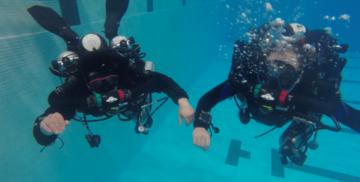
A pair of Faber LP50’s filled “Florida Style” with a bottom trimix is more preferred for experienced rebreather divers.
For the Same Dive the LP50’s would bring the diver into the 55msw/180fsw range easily, switching to the 21/35, then up to the next deco phase at either 21msw/70fsw or 30msw/100′ and up to the 9m/20fsw phase where another AL80 of oxygen would be required.
It’s so important to plan ahead and plan for the worst, as you don’t want to be left with any surprises, and while a flooded rebreather or a total loss of your PO2 monitoring equipment is rare, which can happen, as can regulator failures, burst disc ruptures and more, but that’s why they call them a failure. They’re unplanned.
Being Proficient in at minimum of 2 AL80 Stages is why I always encourage Divers to get to at least the Cave 2 or Trimix 1 level.
Maintenance
The pre-dive setup and post dive teardown of a rebreather could take far longer than the planned dive. Some units are easier to assemble and teardown than others, which should be a consideration.
Maintenance, pre-diving evaluation of all components which should be frequently inspected, as well as changing of the oxygen sensors every 6-12 months, servicing the regulators, fittings, o-rings, injection equipment should all be factored in.
If a leak is detected in the unit, it can cause more problems in the event of an emergency, as a flooded rebreather can have an unfavourable effect if the scrubber becomes wet, causing a “caustic cocktail” which can be an instant retching action that can cause the diver to go into a choking reflex as you ingest this corrosive, alkaline cocktail. If a Diver tries to bail out to open circuit on a separate regulator they may involuntarily inhale more water, while simultaneously retching and possibly drown, this is where a Bail Out Valve or BOV is a very smart piece of equipment. The BOV has a switch on the rebreather that allows you to open the breathing loop from closed circuit to an open circuit regulator.
The diver will then be able to breath or barf and breath through the second stage as they take sanity breaths for a couple of minutes. Students are taught to purge empty the rebreather from water on their CCR Course.
Instead of a BOV, some rebreather divers use a DSV (Dive Surface Valve) to allow them to breath surface air topside. This could be more risky in a caustic environment as the diver doesn’t have the ability to switch off closed circuit to open circuit in the even of a caustic cocktail, so utilizing a necklace under the chin reminiscent of how modern divers dive with a long hose/short hose configuration is the only reasonable option to get breathable gas if the unit is flooded.
People love the “Cool Factor”, but I wholeheartedly caution those who don’t cut it at the recreational or entry-level technical diving level to wake up and seriously ask yourself if you’re ready for all that CCR Diving entails.
A friend of ours who passed away recently ago used to say he never dove a rebreather because he had friends who were Doctors or Lawyers with more letters that were in front of their names who died on them.
Diving a Rebreather is more commonplace now, but unless the dives are super deep (below 150’ or more) or super long like those maybe a Marine Research Diver would be participating in, the reality is that diving Open Circuit is the more efficient choice for the average person.
Rebreathers require a much higher degree of attention, diligence and understanding of how the unit works. The simpler the unit, the easier it may be to fix on the fly in the event of an equipment related issue. You should always have multiple ways to receive breathable gas in an emergency, so always do your positive and negative checks, and test out the mushroom valves, regulators, fittings and practice drills regularly to keep your problem solving skills sharp.
Have a well stocked rebreather Save a Dive Kit of spare o-rings, regulator parts, breathing hoses and sensor(s).
Keeping Your Rebreather in “Dive Ready Condition” is a Must.
Pre-Dive Checks, Calibrating the Instruments, verifying flow rates (if applicable), packing your scrubber, then cleaning and disinfecting the unit is all part of rebreather diving. Don’t be lazy and don’t be complacent.
Diving a Rebreather requires diligence and being familiar with all the inner workings of the unit.
Things to Consider.
Which Side does the oxygen inject in from? Before or after the gas is analyzed? Does it have an ADV or a T-Block Piece? How many different ways can you get breathable gas if you need it? How does the unit breath flooded? Is the unit reliable? Does it work in cold water or just warm water? Is it lightweight for travel? Do you need to wear weights with it and how much? Is the cost of the unit agreeable?
What are the entry requirements to training on a Rebreather? Agencies who make it “too easy” don’t get the big picture. Train harder, skill up and then go to a rebreather. Don’t Take Short cuts. See my previous blog post What’s The Hurry, What’s The Rush?.
You’re making a decision that can cost you over $10’000.00USD. Do Your Research, but more importantly talk Us. We do get Demo Units as well sometimes as trade-in’s. We currently have a Sentinel CCR up for grabs.
Book a Try Dive with Us and see why our way is the best way.
All too often Divers go blindly into purchasing a rebreather and it’s not until they start putting the hours on their units do they realize they purchased the wrong one.
In Closing
Rebreathers are a lot of fun, as you can extend your dive times, see more creatures up close and more personal, it buys you time in an emergency if you’re trapped in a shipwreck or a cave to find an exit in the event of a collapse making them a safer choice for extreme cave diving and the deepest shipwreck diving.
50-100 Trimix Dives will more than pay for the rebreather and the training, so get your hours up in Open Circuit, get proficient with multiple stage bottles and let’s help you become a Rebreather Explorer.
